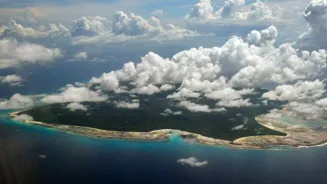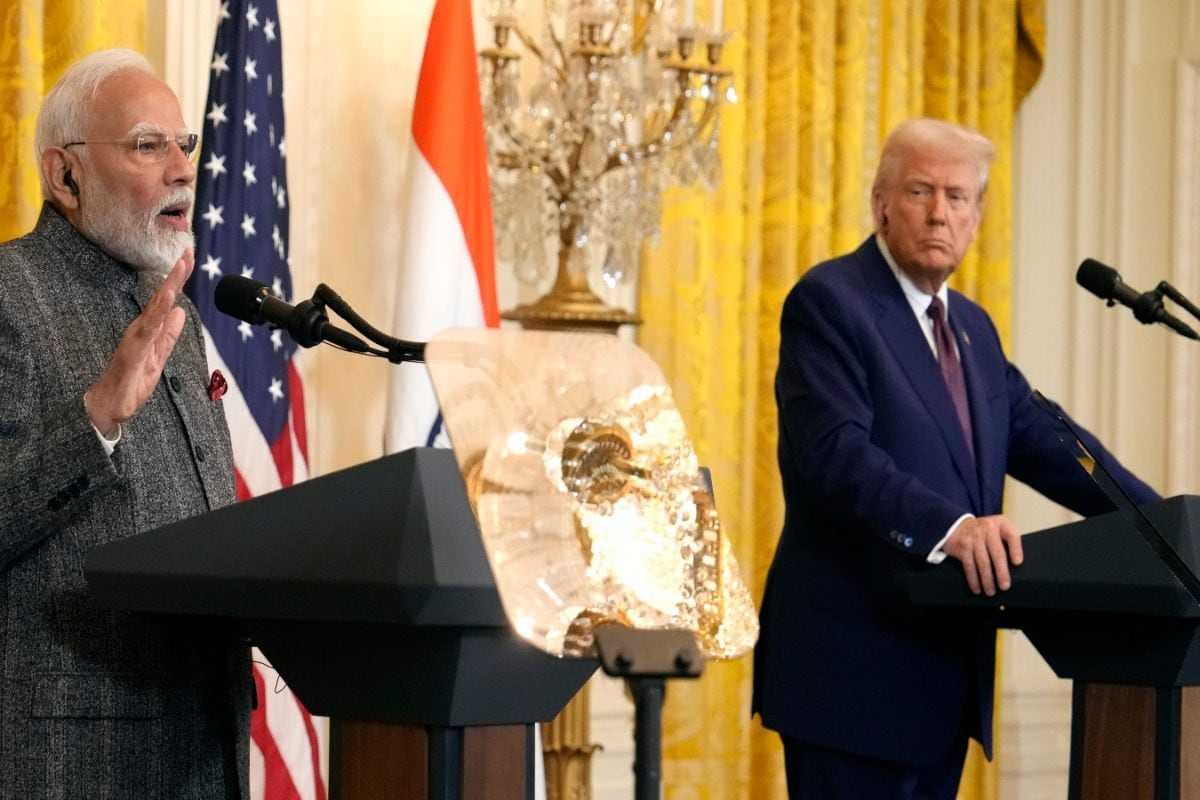What is the story about?
Like a sharpshooter methodically chambering rounds before a high-stakes standoff, India is fortifying its most valuable maritime outpost—the Andaman and Nicobar Islands. As the Quad appeal lessens amid the US downgrade of India as
a security partner, New Delhi has emphasised geography. The 572 islands in the Bay of Bengal, long overlooked, are being transformed into what strategists call an unsinkable aircraft carrier, projecting power across the Indo-Pacific’s turbulent waters.
The pivot makes sense. China’s navy, once confined to its coastal shallows, now roams the Indian Ocean with the confidence of a rising hegemon. Submarines slip through chokepoints, and spy ships spend a long time in India’s littoral as routine. So, the Andaman Islands are the strategic outpost
to compete.
At the heart of this strategy lies the Six Degree Channel, also known as the Great Channel, a 163 km-wide passage between Great Nicobar and Indonesia’s Sumatra. Through it flows a quarter of global maritime trade, including 80 per cent of China’s oil imports. Some 94,000 ships pass annually, making it a lifeline. For India, dominating this artery means holding a chokehold on potential adversaries. Unlike the Malacca Strait, farther east and shared with allies, the Great Channel offers New Delhi unilateral leverage—monitoring traffic in peacetime, interdicting it in
crisis.
The islands’ position amplifies this advantage. Stretching 800 km from Myanmar to Indonesia, they guard the entrance to the Indian Ocean from the South China Sea. China’s “Malacca dilemma”—its vulnerability to blockade—becomes India’s opportunity. Beijing knows this: its survey ships have probed nearby waters, and it has leased Myanmar’s Coco Islands, just 55 km north, for what many suspect are listening posts. India’s response? A muscular buildup to turn vulnerability into strength.
Enter the Rs 5,650-crore masterplan, a ten-year blueprint to militarise the archipelago against China’s expanding footprint. Approved amid rising tensions, it aims to station more warships, aircraft, missile batteries, drones and troops. Supply lines stretch 1,200 km from the mainland, demanding self-reliance—hence the hefty price tag. But the investments span six key areas, blending naval, air and infrastructure muscle.
First, the navy is lengthening runways at INS Kohassa in Shibpur, North Andamans, and INS
Baaz at Campbell Bay in the south. Both will extend to 10,000 feet, allowing heavyweight aircraft like Boeing P-8I Poseidons for anti-submarine warfare. INS Kohassa was commissioned on January 24, 2019, by then-navy chief Admiral Sunil Lanba; recent extensions underscore ongoing momentum.
Second, the Indian Air Force is upgrading Car Nicobar’s station for fighter squadrons, adding radar coverage for anti-missile defence and hangars to support extended deployments. This complements Port Blair’s INS Utkrosh, now equipped for
surveillance drones.
Third, new jetties are rising to berth larger vessels, turning temporary anchorages into permanent naval hubs. Fourth, road networks are expanding for swift troop movements. Fifth, permanent barracks and logistics depots will house division-strength infantry, lessening reliance on mainland rotations. Sixth, advanced surveillance—radars, sensors and missile systems—will create a digital shield, spotting intruders from afar.
These aren’t pipe dreams. In the past 30 days alone—as of early
August 2025—defence officials have inspected progress, with Shibpur’s runway work accelerating. Port Blair and Car Nicobar airports already handle military ops; the extensions at Shibpur and Campbell Bay will supercharge them. It’s a far cry from the archipelago’s sleepy past, when limited airstrips confined operations to light aircraft.
Yet the real edge comes from alliances that endure. Amid Quad uncertainties, the “Fish Hook” partnership with America and Japan—a submarine surveillance network—stands firm. This chain of
underwater sensors, stretching from Japan to the Andamans, tracks Chinese subs like a digital dragnet. Born of Cold War tech, it weathers tariff spats, offering India early warnings against Beijing’s 60-plus submarine fleet. For a navy with just 13 conventional subs, it’s a vital equaliser, monitoring movements through the Great Channel.
Challenges abound. The islands’ isolation inflates costs; everything from cement to soldiers must cross the Bay of Bengal. China’s shadow looms with its navy, with 3-4 task forces
patrolling the Indian Ocean. India’s stretched logistics could falter if projects drag.
Execution is key.
Like an admiral priming his fleet for the decisive salvo, India is positioning the Andamans to command the littoral. In an era of waning coalitions, these islands offer enduring might—guarding trade, deterring foes, and securing a multipolar Indo-Pacific. The duel is on; India, chamber loaded, stands ready to fire.
The writer is a senior journalist with expertise in defence. Views expressed are
personal and do not necessarily reflect those of Firstpost.
The pivot makes sense. China’s navy, once confined to its coastal shallows, now roams the Indian Ocean with the confidence of a rising hegemon. Submarines slip through chokepoints, and spy ships spend a long time in India’s littoral as routine. So, the Andaman Islands are the strategic outpost
At the heart of this strategy lies the Six Degree Channel, also known as the Great Channel, a 163 km-wide passage between Great Nicobar and Indonesia’s Sumatra. Through it flows a quarter of global maritime trade, including 80 per cent of China’s oil imports. Some 94,000 ships pass annually, making it a lifeline. For India, dominating this artery means holding a chokehold on potential adversaries. Unlike the Malacca Strait, farther east and shared with allies, the Great Channel offers New Delhi unilateral leverage—monitoring traffic in peacetime, interdicting it in
The islands’ position amplifies this advantage. Stretching 800 km from Myanmar to Indonesia, they guard the entrance to the Indian Ocean from the South China Sea. China’s “Malacca dilemma”—its vulnerability to blockade—becomes India’s opportunity. Beijing knows this: its survey ships have probed nearby waters, and it has leased Myanmar’s Coco Islands, just 55 km north, for what many suspect are listening posts. India’s response? A muscular buildup to turn vulnerability into strength.
First, the navy is lengthening runways at INS Kohassa in Shibpur, North Andamans, and INS
Second, the Indian Air Force is upgrading Car Nicobar’s station for fighter squadrons, adding radar coverage for anti-missile defence and hangars to support extended deployments. This complements Port Blair’s INS Utkrosh, now equipped for
Third, new jetties are rising to berth larger vessels, turning temporary anchorages into permanent naval hubs. Fourth, road networks are expanding for swift troop movements. Fifth, permanent barracks and logistics depots will house division-strength infantry, lessening reliance on mainland rotations. Sixth, advanced surveillance—radars, sensors and missile systems—will create a digital shield, spotting intruders from afar.
These aren’t pipe dreams. In the past 30 days alone—as of early
Yet the real edge comes from alliances that endure. Amid Quad uncertainties, the “Fish Hook” partnership with America and Japan—a submarine surveillance network—stands firm. This chain of
Challenges abound. The islands’ isolation inflates costs; everything from cement to soldiers must cross the Bay of Bengal. China’s shadow looms with its navy, with 3-4 task forces
Execution is key.
Like an admiral priming his fleet for the decisive salvo, India is positioning the Andamans to command the littoral. In an era of waning coalitions, these islands offer enduring might—guarding trade, deterring foes, and securing a multipolar Indo-Pacific. The duel is on; India, chamber loaded, stands ready to fire.
The writer is a senior journalist with expertise in defence. Views expressed are
Do you find this article useful?















